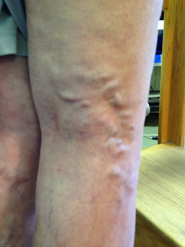Understanding Varicose Veins
By Miller Vein Team
View the original post: blog.millervein.com

How do I know if I have Varicose Veins?
Varicose veins are abnormally enlarged, swollen veins that are visible on the surface of the skin. Varicose veins develop as a result of the medical condition venous insufficiency or venous reflux.
What is venous insufficiency & how does it develop?
The heart pumps blood to your organs and tissues. The blood carries oxygen and nutrients to keep your body healthy and functioning properly. When the blood goes to the lower extremities, it must work against gravity to return to the heart to be recirculated. In the legs, a combination of muscle contractions and valves in our veins push blood back up to the heart. Varicose Veins develop when the valves in a vein become weak or damaged and don’t close properly. An impaired valve can cause blood to flow backwards and pool in the leg. Venous insufficiency is a medical condition in which the blood flow is impaired through the veins.
Symptoms of Venous Insufficiency include:
- Pain/Aching/Throbbing of Legs
- Heaviness or leg fatigue
- Swelling of feet/ankles
- Restless Leg Syndrome
- Night cramps
- Itchy veins
- Varicose veins
- Non-Healing ulcers
You may experience symptoms of venous insufficiency without the enlarged, swollen veins showing on the skins surface. What many people don’t realize is venous insufficiency may be present even if there aren’t any varicose or spiders veins on the surface of the skin.
Most insurance companies cover varicose vein treatment if the medical condition causes symptoms that limit activities of daily living.
To find an AVLS member vein care provider in your area, please visit: www.phlebology.org/providers


